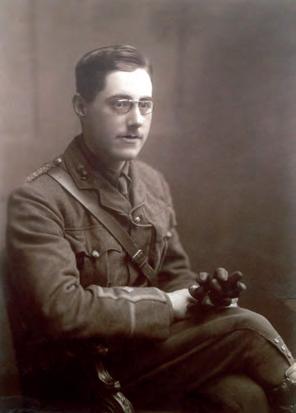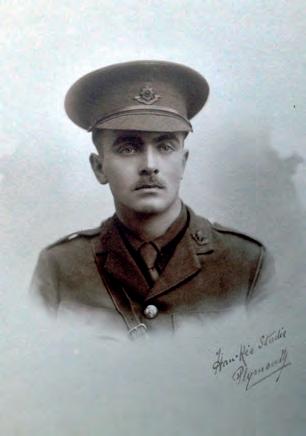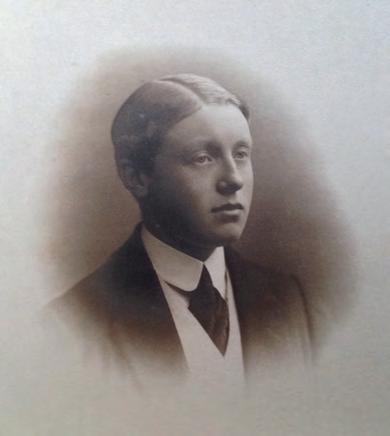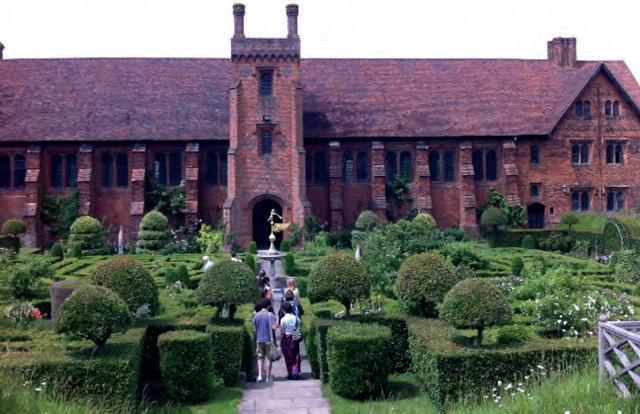
17 minute read
The College and the Great War – Magdalene’s ‘lost generation
the college and the great war
MAGDALENE’S ‘LOST GENERATION’, 1914–1918
Advertisement
Of the hundred undergraduates expected to come into residence in October 1914, barely half turned up. During the course of the next four years it was said that practically the whole College enlisted. Of the schoolboys with awards or places, 45 immediately joined the forces instead of coming up; of these twelve were killed in action. By October 1916 there were only six freshmen admitted, three the following year, six in October 1918. By the Easter Term 1915 there were 29 undergraduates in residence; in the Easter Term 1918 the number had fallen to nine, of whom three were medically unfit for the services, two were Indians, four from Siam – young men stranded in Europe for whom the College provided a refuge. Physically-fit eighteen-year-olds from the UK were simply expected to fight and were unlikely to be very welcome in College. (In the autumn of 1914 the Master, S A Donaldson, had resigned his honorary presidency of Cambridge Town Football Club in protest against its decision to play a full fixture-list, when the men were needed for the army.) Empty College rooms were quickly filled by officers on training courses.
Magdalene was still a very small College, with fewer than 200 students passing through it between 1908 and 1913, yet 65 members were killed in action or died of their wounds. The following account, based on reports in the College Magazine during the war years, tells their story. It is an edited extract from a more comprehensive article by Professor Ged Martin (1964, formerly Research Fellow).
Devotees of Blackadderwill recall the story of the Trinity tiddlywinks team rushing to the recruiting office on King’s Parade the day the war broke out. In fact the Germans attacked in the depths of the Long Vacation, but a few students were in residence. The Magdalene Tutor, A S Ramsey, returned on 5 August 1914 from an examiners’ meeting in Oxford to discover that three of his tutorial pupils ‘had left Cambridge at midnight on their motor-cycles to offer themselves as despatchriders for service with the expeditionary force…. They did not wait to ask leave or to consult their parents, but just left a message to say that they had gone’. Ramsey saw their gesture as ‘significant of the spirit of the times’. All three joined the Royal Engineers. Two survived the war. T Daish was mentioned in despatches in 1916, and won the Military Cross the following year; J N Perks also served throughout. A product of Rugby School, Roger Paul Hepburn graduated in 1914 with a First in Natural Sciences. After eight months as a despatch-rider on the Western Front, he was commissioned as a second lieutenant – a junior rank with a notoriously high death-rate – and retrained as a signaller. He returned to the front in November 1915 as a brigade signal officer, was wounded in February 1916, went back to the trenches, where he was awarded the Military Cross in June 1917, two months before he died of his wounds.
Magdalene officers made light of the dangers they faced. In November 1914, one gave his initial impressions to the Magazine from the trenches near Armentières, ‘It’s not too bad…. The one I’m in now is known as the “Death Trap”’. Mercifully, there was a lull in German shelling. ‘I must say that some of their
gunners are infernally good shots.’ They were also methodical. ‘It is funny that they almost always shell at the same time’ – around 10 a.m., again at 12.15, ‘always knock off from 12.30 for 1 hour, the luncheon interval’. The Germans trenches were only 300 yards away, ‘and one can easily see them shovelling the dirt out. Occasionally they put a head up and we have a shot. They sometimes signal misses with their shovels. It’s a bit parky at night…’.
Roger Paul Hepburn, 1893–1917
The first College fatality came on 20 October. Meyricke Entwisle Lloyd was an Etonian who had spent a year in Magdalene in 1898–99, before joining the exodus of undergraduates to the South African War. The Magazine placed him in Northamptonshire, but the family came from Montgomeryshire. Lloyd had remained in the Regular Army after the South African War, and was promoted to Captain in the Royal Welch Fusiliers. Lloyd would be the first in a death-toll that would eventually reach 65, although the grim total was slightly inflated by including twelve young men who had been admitted to the College but had enlisted before they came into residence. The death-toll was roughly equivalent to wiping out two matriculation years in the period between 1909 and 1913, or four years from the 1890s. The war claimed victims from relatively distant cohorts. Robert Harvey had graduated as far back as 1894, and had founded an elite private school in Victoria, British Columbia in 1901. In his early forties when war broke out, he might have honourably left the fighting to younger men. He was captured during the second battle of Ypres in April 1915, and died soon after of wounds in a German prison camp. From an even earlier intake was George Williams, who came to Magdalene from King Edward VI Grammar School, Birmingham in 1875. With an Honours degree and fifteen years’ experience as secretary of the Ranelagh
Club, the largest polo club in the world, he secured an appointment on the General Staff and died, the College’s last official war victim, during the influenza epidemic in January 1919. ‘He always spoke affectionately of his old College.’
Around 350 members of the College took part in the War in some form or other, not all of them in a military capacity – equal to the entire number of matricu - lations between 1895 and 1913. Unfortunately, it is difficult to build up an overall picture of social background and educational achievement. The Magazine’s short tributes to the fallen were inconsistent in the biographical information supplied, although enough was conveyed to give colour to the ‘lost generation’ theory, the haunting sense that the brightest and best were sacrificed. Godfrey Bull, who was killed at the Dardanelles, had joined an engineering works in Manchester after Cambridge. ‘He was making very satisfactory progress in his profession,’ a friend wrote, ‘and was one of the very many whom England can ill afford to lose.’ While it is possible to construct some impressionistic overall picture of those who died, the absence of biographical information makes it harder to know whether they stood out among their contemporaries – perhaps the victims of their own dash and brilliance. The cox and three members of the 1914 May Boat were killed, and a fourth was wounded. However, rowing was a minority interest in Magdalene, and it would be unsafe to draw deductions from this record, however tragic.
Godfrey J O Bull, 1890–1915
The list of those serving in the war was also eclectic in its definition of service, for instance including two former members who worked with the YMCA. ‘Somewhere in Flanders’ was a YMCA centre called, with the permission of the Master, ‘Magdalene’. Located in a cellar – everything above ground in the village

had been destroyed – ‘Magdalene’ provided free hot cocoa, a warm fire and reading matter. Second Lieutenant Arthur S Macpherson of the Labour Corps appealed for novels, cheap editions of the classics and magazines. Also included in the list was I A Richards, later one of the College’s most notable intellectuals, who had suffered from tuberculosis, but was included thanks to his service in the Inquiry Bureau at a military hospital – an episode omitted from standard accounts of his life.
B Winnington Hill (‘Guy’), 1892–1917


Kenneth F Watson, 1893–1915
Given the popular perception that fighter pilots were young public school heroes, it seems remarkable that Magdalene produced only a handful of airmen. Yorkshireman Kenneth Watson read for the Diploma in Agriculture, and was tipped to get his Rugby Blue in the Michaelmas Term of 1914. Instead he joined the Royal Naval Air Service, and was lost at sea on patrol in August 1915. Beresford Winnington Hill, known as ‘Guy’, was a Classics Scholar who was a member of the University’s Officers’ Training Corps (OTC) throughout his three years in Cambridge. This secured him a commission in the Rifle Brigade at the outbreak of war, but he switched to the Royal Flying Corps after being wounded in the trenches. Life expectancy for pilots was short: posted to the front in February 1917, Hill was killed on 4 March. The news shattered his closest friend, who had rowed in the same boat and sat in the same examination rooms. ‘For the past five days I have been trying to realise that he is dead, and even now I can hardly bear to think of it…. There never was such a fellow as Guy, and what we’re going to do without him I don’t know.’
The Royal Air Force was consolidated as a separate service in April 1918, when the War had seven months to run. With a high proportion of its personnel providing technical support behind the lines, it was perhaps likely to have a lower casualty rate. Only two of the eighteen members of the College then listed with the RAF lost their lives. An Exhibitioner in Classics, Harold Winton joined the Middlesex Regiment in September 1914, later transferring to the Royal Flying Corps. He was sent to the front as a pilot on 6 April 1918, and was killed in an accident fifteen days later. A Scholar in Mathematics who had come up in 1912, A C Sotheron-Estcourt had won the Military Cross with the Gloucestershire Regiment before training as a pilot. He died in August 1918. Among the survivors were Francis Turner (later Pepys Librarian, Tutor and President), and the two Magdalene men who would command the Allied air forces in the invasion of Normandy in 1944, Trafford Leigh-Mallory and Arthur Tedder. Both were decorated, Leigh-Mallory winning the DSO and Tedder receiving an Italian medal. They became career flyers: in 1919, the Magazine welcomed the news of Tedder’s posting to a Cambridge-based RAF unit, noting that he looked ‘more like a General than anything we have seen for some weeks’. He would crown his long career as Marshal of the Royal Air Force, GCB, and by serving as Chancellor of the University.
This sample of Magdalene airmen is small, but it may be worth noting that they came from the second-rank of independent schools: Hill from Malvern, Watson from Sedburgh and Leigh-Mallory from Haileybury. Sotheron-Estcourt had attended Gresham’s Holt, a small but highly regarded Norfolk boarding school. Shrewsbury, which educated Winton, was a foundation with traditional links to Magdalene but lacking the prestige of Eton, Harrow or Winchester. Tedder came from Whitgift in South London, which was officially styled a grammar school in his time. Of the four airmen who were killed, two were Scholars and one an Exhibitioner. In 1914, Leigh-Mallory was planning to read for the Bar, while Tedder’s dissertation had just won the University’s Prince Consort Prize, probably the first formal piece of post-graduate work in History to come out of Magdalene.
Only around a dozen Magdalene men served in the Royal Navy, mostly RNVR who seem to have acted in a training role, plus a couple of chaplains. It seems unlikely that more than a handful of members of the College actually went to sea, although one RNVR lieutenant, J L P Lambe, in residence from 1913 to 1915, was twice torpedoed. Overwhelmingly, members of Magdalene served in the Army. Although some had been members of the OTC during their time at Cambridge, it goes without saying that few had seriously contemplated fighting in a war. At least five of those killed in action had planned careers in the Anglican Church. George Nash, a History Scholar from Repton, was already preparing for ordination at Cuddesdon when War broke out: he was killed in June 1915. John Morris, who graduated in 1914, had planned to enter another theological college, Wells, but he accepted the ‘unpalatable’ advice of a friend that it was his duty to fight. He was killed at Suvla Bay, Dardanelles in August 1915: ‘he would have made an excellent parish priest’. Arthur Kelk, from Leeds Grammar School, had paved
the way to ordination by taking a Third in the Theological Tripos in 1914. He received a commission from a ‘pals’ battalion, won the Military Cross, and was killed in 1917. Some could probably have avoided the trenches. Charles Watson was dangerously ill when war broke out, but secured a commission in 1915, and won the Military Cross. Harrovian Robert Williams refused to allow a heart defect to keep him out of the Grenadier Guards. Both lost their lives.
George Nash, 1890–1915


Charles Beaumont Watson, 1894–1918
As Cambridge men, they were regarded as natural officer material. A few seem to have enlisted as privates but were quickly promoted. A rare exception was James Harter, an Etonian whose five years in the school OTC would have guaranteed him a commission. However, he enlisted in September 1914, insisting that ‘he must learn his work before he took the responsibility’. He remained in the ranks for nearly two years before being commissioned as a second lieutenant, and died leading an attack on a Turkish position in November 1917. The colonies were perhaps more socially democratic – Magdalene had a corporal in the Australian Army Medical Corps, a private in the Rhodesia Regiment, and a Trooper with the New Zealanders – but most of the handful who served in the overseas Empire were European officers commanding non-white troops – in India, Burma, Singapore and the King’s African Rifles. Just thirteen members of the College held commissions in the elite Guards’ regiments – compared with fourteen who were officers in the Royal Engineers, conventionally thought of as the brains of the Army. Guardsman Tom Musgrave, a ‘youthful and charming’ Etonian, was commissioned after Cambridge in the Irish Guards but went out to Kenya to
become a pioneer farmer. He returned to his regiment when war broke out and arrived in France on 9 January 1915. Four weeks later, Musgrave out-ran his men as they attacked a German position, and was firing into the enemy trench from a parapet when a shot killed him instantly. ‘He was very happy here – perhaps almost too happy to do much work!’, remarked the Magazineof this ‘simple, lively, and generous’ personality, adding ‘it is sad to think that we shall never see him here among us again’.
Tom Musgrave, 1889–1915
The Magdalene soldiers were generally captains, first and second lieutenants – the junior officers who led troops into action and paid the price for their heroism. And there can be no doubt that they were brave. No fewer than 47 of them won the Military Cross, three of them twice. There were five DSOs, Owen Morshead (later Pepys Librarian and Life Fellow) also winning the MC. Francis Turner earned the Distinguished Flying Cross, and survived a plane crash that left him with lifelong facial injuries. There were a few decorations awarded from Allied countries –France, Belgium and Italy – and one notable distinction for acts of courage not in the presence of the enemy. Lieutenant Henry Higgs, a 1908 Maths graduate, was an instructor in the use of hand grenades. Nervous officers were liable to drop their bombs and, on one occasion, one man accidently jostled his neighbour, jerking the grenade from his grasp. On more than a dozen occasions, Higgs had leapt forward and seized the bomb, which exploded harmlessly after he had thrown it over a parapet. He was awarded the Albert Medal, forerunner of the George Cross, and ended the War a lieutenant-colonel.

Naturally, there was some time lag between heroic actions and the gazetting of medals. The family of John Dennis, from Wisbech Grammar School, read the announcement of his Military Cross on the same day in October 1916 that news reached them of his death. By no means every act of gallantry was honoured. Theodore Barlow was a Classics Exhibitioner who led his men into attack on the Somme. Wounded in the leg, he took refuge in a shell hole, ‘cheering on his men, when a bullet hit his chest. Still he kept his head above the shell-hole to urge his men on to greater effort; a third wound put him out of action’. His men stormed their objective, a German trench, but Barlow died of wounds six days later. James Harter’s commanding officer offered the consolation that he ‘would most certainly have had an MC if he had come out alive’ after leading his men in a successful charge against a fortified Turkish position. And the killing continued to the end, despite the modern narratives that portray the Germans as crumbling from August 1918. History Scholar John Macfadyen was a Hertfordshire Scot who became adept at managing the new war-winning weapon, the tank. Facing the German onslaught in March 1918, he kept his tank operating despite two direct hits and, on his own initiative, mounted four attacks in support of infantry. ‘His courage and dash were most marked.’ His Military Cross was gazetted on 17 July, but he was killed in August.
Inevitably, some of the dead inspired more emotional tributes than others. Two perhaps stand out, both from 1915 but for very different men. The loss of Kenneth Watson (see p 66) with the Royal Naval Flying Corps produced perhaps the longest obituary in the Magazine, which concluded: ‘Beneath a most attractive exterior lay the finest character, at once serious and engaging, affectionate and strong: when accounts come to be made up and losses reckoned, it may be said that without hesitation that it will be found that there was none of our men whose death will have left a more cruel sense of loss in the hearts of his contemporaries and elders’ (ending with a Latin quotation from the Vulgate). Watson would be remembered for his athletic prowess. Leonard Herman Stern, on the other hand, achieved academic distinction and was a particular loss to the Jewish community of London’s East End. Son of a rabbi and educated at the middle-class University College School, he came up as a Scholar, also holding the Cambridge Jewish Exhibition. He obtained a First in Classics in 1913 and went on to sit the Historical Tripos the following year. He played Rugby for the College, and was an active participant in its intellectual coterie, the Kingsley Club, as well as university Jewish organisations and the OTC. In Stepney he was manager of the Lads’ Club, and a scoutmaster, setting an example by enlisting with a number of his lads in the 13th Battalion of the London Regiment. He later obtained his commission and left for France, where he died after just five weeks. His commanding officer was quoted in the Magazine: ‘he met his death leading his men in the true British way… and gave great promise as an officer’.
Leonard Herman Stern, 1891–1915 Memorial in the East London Synagogue. Note ‘Garde ta foy’ at the top.


The College death-roll of 65 represented 1 in 5 of combatants, which was about average for an Oxbridge college, though the national average was 1 in 8. A memorial tablet with all their names inscribed was dedicated in the College Chapel on 11 November 1923. The Master, A C Benson, declared: ‘Few of those who are here present have known face to face these brothers of ours; but their names are held in honour, and their memories are dear. We honour them, because, in the words of our old motto, they kept their honour unstained; we love them, because they offered the sacrifice of love’. Ged Martin
A full version of this article, ‘Magdalene College Cambridge and the First World War’, appears on www.gedmartin.net. Click on the section ‘Martinalia’ and follow the links.









